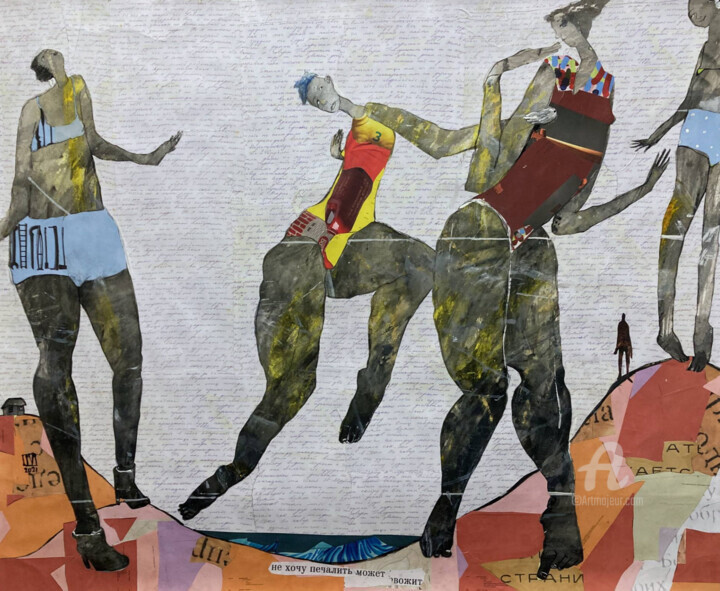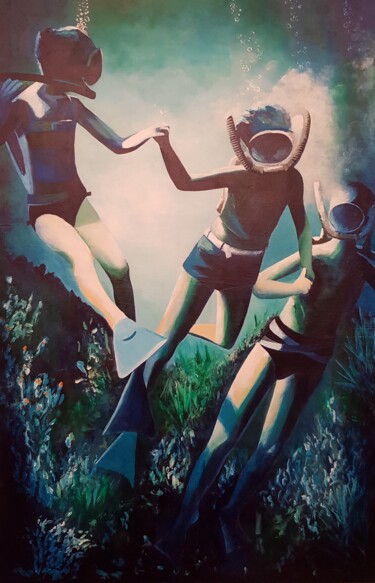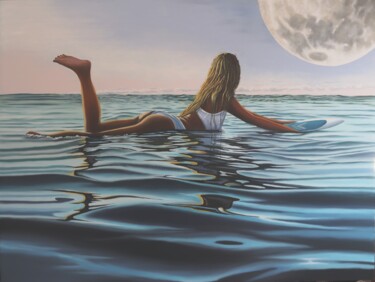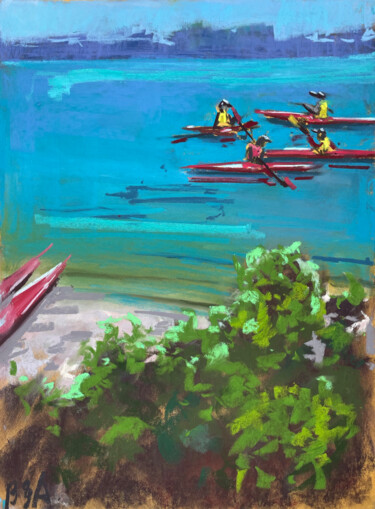 Ilya Volykhine, Saucy, 2021. Oil / ink on paper, 90 x 108 cm.
Ilya Volykhine, Saucy, 2021. Oil / ink on paper, 90 x 108 cm.
Celebrating the now approaching arrival of summer, it is impossible not to refer to some of the great masterpieces of the past, and of contemporary art, that have immortalized beach life, that is, situations in which humans fully enjoy, with joy, pleasure, lightheartedness and relaxation of the beauty and pleasures offered by the proximity of the sea. In this context, the infinite possibilities of representation of such a subject strongly emerge, due precisely to the very peculiarities of the sea, such as eternal evolution and movement, which made it an interesting subject to capture at any time and in any weather condition. Added to the above is the richness of the varied ways in which bathers enjoy the beach, which, with multiple attitudes, can be immortalized in relationship with nature. In addition to the above, surely, the masters who have tried their hand at depicting beach life have also been able to express their innermost emotions, which, mirrored by the variability of human actions and the land-water dualism, have made their works genuine timeless masterpieces.
 Stefano Galli, Sunday at the beach in late summer, 2014. Acrylic on canvas, 50 x 50 cm.
Stefano Galli, Sunday at the beach in late summer, 2014. Acrylic on canvas, 50 x 50 cm.
 Alena Shymchonak, Reserved; chill out, 2018. Oil on canvas, 100 x 80 cm.
Alena Shymchonak, Reserved; chill out, 2018. Oil on canvas, 100 x 80 cm.
Some masterpieces that immortalize beach life
It is surely impossible to list and describe all the many works, including painting, photography and performance, that have immortalized beach life and, consequently, also the changes in the sea motions and customs of bathers over time. Nonetheless, John Constable's Brighton Beach (1824) and Edvard Munch's Bathing man (1916) are certainly noteworthy, though oftentimes little known. As for contemporary art, however, we can refer to Le grand saut (2017) by Joost Wensveen and Sea and Sun (Marina) (2019) by Lina Lapelyte, Vaiva Grainyte, and Rugile Barzdziukaite.
 John Constable, Brighton Beach, 1824. Oil on paper, 16 x 30 cm. London: Victoria and Albert Museum.
John Constable, Brighton Beach, 1824. Oil on paper, 16 x 30 cm. London: Victoria and Albert Museum.
Joost Wensveen, Le grand saut, 2017. Photography.
About Brighton Beach, it is important to highlight how this masterpiece was born out of a specific family condition, experienced firsthand by the English artist. Indeed, Constable's wife, who contracted tuberculosis, prompted the master to frequent Brighton beach (UK) between 1824 and 1828 in the hope that the sea air would benefit her health. Although this place inspired some of the artist's masterpieces, he was not able to fully enjoy the sea air, for, as shown in a letter the master himself sent to John Fisher in 1824, Constable considered Brighton the receptacle of London fashion and decay, capable of drowning out the magnificence of the sea. Nonetheless, Brighton Beach conveys the calmness and serenity of the English coast, where, the wet few equipped with parasols, are lost in an expanse of sky and salt water. As for Munch's work, on the other hand, it too is marked by a personal affair; in fact, the Norwegian master moved, in 1916, to Ekely in order to enjoy a quieter life, which, far from the city and its hectic pace, could offer him a simple existence closer to nature. It was in this very location that the oil painting Man at the Bath was born, in which Munch clearly expresses a newfound joy of living, in accordance with those reform currents, which, spreading in Germany at the end of the century, preached escape from the city and the search for alternative patterns of life. In the world of contemporary art, on the other hand, Le grand saut (2017) by Joost Wensveen, a Dutch artist, stands out. Wensveen uses a very particular technique in the making of his photographs of beach life. In fact, he, in order to achieve a natural and spontaneous effect, exploits the combination of several photographic shots. Just in Le grand saut, Wensveen shot a scene during 30-minute intervals, which were merged into a single work of art. Finally, also noteworthy is Sea and Sun (Marina) by Lina Lapelyte, Vaiva Grainyte, and Rugile Barzdziukaite, a thirteen-voice work-performance, which, presented at the 2019 Venice Biennale, showed an invented beach, where people lay on their towels, playing with sand and putting on sunscreen. It is good to highlight how, in this seemingly carefree context, a sad lyrical song referred to the inexorable loss of the ecosystem.
 Thomas Lange, Woman Chillout #M106, 2022. Acrylic on linen canvas, 40 x 50 cm.
Thomas Lange, Woman Chillout #M106, 2022. Acrylic on linen canvas, 40 x 50 cm.
 Alexandra Djokic, Jump, 2022. Acrylic on linen canvas, 120 x 160 cm.
Alexandra Djokic, Jump, 2022. Acrylic on linen canvas, 120 x 160 cm.
Beach life in the works of Artmajeur artists
Just like the great masters of the past, and of the present, the artists of Artmajeur have also been inspired by the changing nature of the sea and, consequently, the adaptability of bathers. Indeed, although the topicality of beach life has undergone variations over the centuries, brought about mainly by the succession of fashions and lifestyles, there are certain themes that have remained unchanged over time, such as, for example: children's games on the beach, the undressing of the bathers, and partial, or total, human nudity. Such affinity of subject matter, presented by the great masterpieces of the past with the works of our present, make it clear that bathing actions and attitudes have remained fundamentally the same. In particular, the above is evident from the artistic experimentation of Rita Pranca, Anastasia Chernysheva and Georg Dienz, aimed at depicting some of the most iconic themes of beach life.
 Rita Pranca, At the beach, 1997. Oil on canvas, 140 x 170 cm.
Rita Pranca, At the beach, 1997. Oil on canvas, 140 x 170 cm.
Rita Pranca: At the beach
Certainly, beaches where it is permitted to present oneself nude are less common than those where it is obligatory to show oneself clothed or in a bikini, nevertheless, such type of approach to life, and especially to the sea, turns out to be a very successful subject in the history of art, involving masters of all times. In fact, works that juxtapose the nude with the seascape turn out to be very rich and interesting, as they allow us to evaluate the landscape approach together with the anatomical one, merging two artistic genres that are often quite distinct from each other. In addition, The appeal of "beach nudes" is celebrated by multiple masterpieces in art history, such as: Neapolitan Children Bathing by Singer Sargent, Bathers in Saint Tropez by Maximilien Luce, Bathing Boys (1909) by Max Liebermann, and Bathing Boys (1910) by Verner Thomé. It is precisely in this context of great tradition that the painting At the beach is placed, where, compared to the aforementioned predecessors, the interest in the human body becomes clearly more pronounced, thanks to a close focus on the bodies, which tends to partially "blur" the presence of the beach.
 Anastasia Chernysheva, Scheveningen: the spring wind, 2022. Oil on canvas, 70 x 70 cm.
Anastasia Chernysheva, Scheveningen: the spring wind, 2022. Oil on canvas, 70 x 70 cm.
Anastasia Chernysheva: Scheveningen: the spring wind
Just as anticipated, one of the themes in art history often associated with beach life is that of children's games. Indeed, oftentimes, the carefreeness of children, and sometimes of young adolescents, is immortalized in works, as evidenced by some masterpieces of the genre, such as, for example: Beach Scene (1869) by Winslow Homer, Children Playing on the Beach (1884) by Mary Cassatt and Running Along the Beach (1908) by Joaquín Sorolla. In this regard, Mary Cassatt's painting, an iconic masterpiece of beach life, in which the artist succeeded in capturing the natural attitude of children, who, immersed in play, are unaware of the inexorable passage of time, deserves a brief focus. In fact, such work offers the viewer a sweet moment of escape and rest, a feeling that is repeated in Anastasia Chernysheva's painting, thanks to which we can go back in time, losing ourselves in the movement of kites.
 Georg Dienz, Surferin. Acrylic on canvas, 240 x 160 cm.
Georg Dienz, Surferin. Acrylic on canvas, 240 x 160 cm.
Georg Dienz: Surferin
The act of undressing, besides being fascinating, erotic and a tad mysterious, as it reveals the whiteness of our figure with the passing of moments, has been immortalized several times in the history of art, and, very often, within paintings set on the beach. An example of the above is Anders Zorn's work, Girls Bathing in the Open Air (1890), in which the sensual maiden in the foreground is intent on removing her clothes, while two other female figures appear to be waiting for her on the seashore. A related concept is expressed by Georg Dienz's painting entitled Surferin, in which a woman of our times, who is undressing, looks toward the horizon, probably pursuing the same intent of reaching the water. Finally, it seems evident how the two paintings are capable of revealing the peculiarities of the eras in which they were conceived, as they highlight refined details, which tell us about the bathing fashions, and customs, of their time.


 Olimpia Gaia Martinelli
Olimpia Gaia Martinelli























